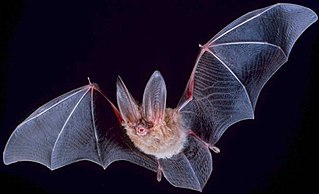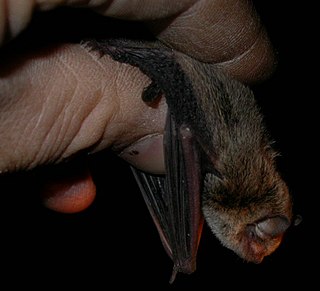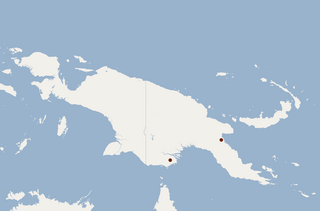
Microbats constitute the suborder Microchiroptera within the order Chiroptera (bats). Bats have long been differentiated into Megachiroptera (megabats) and Microchiroptera, based on their size, the use of echolocation by the Microchiroptera and other features; molecular evidence suggests a somewhat different subdivision, as the microbats have been shown to be a paraphyletic group.

Vespertilionidae is a family of microbats, of the order Chiroptera, flying, insect-eating mammals variously described as the common, vesper, or simple nosed bats. The vespertilionid family is the most diverse and widely distributed of bat families, specialised in many forms to occupy a range of habitats and ecological circumstances, and it is frequently observed or the subject of research. The facial features of the species are often simple, as they mainly rely on vocally emitted echolocation. The tails of the species are enclosed by the lower flight membranes between the legs. Over 300 species are distributed all over the world, on every continent except Antarctica. It owes its name to the genus Vespertilio, which takes its name from a word for bat, vespertilio, derived from the Latin term vesper meaning 'evening'; they are termed as evening bats and once referred to as 'evening birds'.

The New Guinea big-eared bat, species Pharotis imogene, is a vespertilionid bat endemic to Papua New Guinea. It is listed as a critically endangered species due to ongoing habitat loss. It is the only known member of the genus Pharotis, which is closely related to Nyctophilus.

Gould's long-eared bat is a microbat found in southern regions of Australia. It occurs in eastern Australia, from Queensland to Victoria, and in a smaller isolated range in the south-west of Western Australia.

The western or inland broad-nosed bat is a species of vespertilionid bats. They are endemic to Australia and widespread throughout the inland, especially in arid and semi-arid regions. This insectivorous microbat, measuring 12 cm in length, roosts in tree hollows during the day and forages over woodland and water at night.

The Arnhem long-eared bat, is a species of Chiroptera (bats) native to northern regions of Australia. The distribution range is from north-western Queensland to northern Western Australia.

The eastern long-eared bat, species Nyctophilus bifax, is a small flying mammal, a vespertilionid bat. It is found in eastern Australia and Papua New Guinea.

Nyctophilus geoffroyi is a vespertilionid bat, a flying nocturnal mammal found in Australia, The species is relatively common. They have been referred to as the lesser long-eared bat.

The Lord Howe long-eared bat was a vespertilionid bat known only by a single specimen, a skull found on Lord Howe Island in 1972. A mammalian insectivorous species resembling the long-eared Nyctophilus, with an elongated head that is comparatively larger, about which almost nothing is known. The bat may have been casually observed in flight during the twentieth century, but is likely to have become extinct since the island's discovery and occupation. The demise of N. howensis is possibly the result of shipwrecked rats and the owls introduced to control them.

The small-toothed long-eared bat, species Nyctophilus microdon, is a vespertilionid bat. This flying mammal is found only in Papua New Guinea.

The pygmy long-eared bat is a vespertilionid bat, found in the north of the Australian continent. An insectivorous flying hunter, they are one of the tiniest mammals in Australia, weighing only a few grams and one or two inches long.
The southern forest bat is a vespertilionid bat found in Australia.

The little forest bat is a species of vesper bat in the family Vespertilionidae.

The yellow-bellied sheath-tailed bat, also known as the yellow-bellied sheathtail or yellow-bellied pouched bat, is a microbat species of the family Emballonuridae found extensively in Australia and less commonly in parts of Papua New Guinea.

Nyctophilus is a genus of the vespertilionids or vesper bats. They are often termed big-eared bats or long-eared bats, as the length of their ears often greatly exceeds that of the head. This genus occurs in the New Guinean-Australian region.
The pallid long-eared bat is a species of family Vespertilionidae, a flying mammal endemic to northern Australia. They are also referred to as the northern long-eared bat.

The Mount Missim long-eared bat is a species of slit-faced bat found in Papua New Guinea.

The Tasmanian long-eared bat is a species of vesper bat endemic to Tasmania.

Nyctophilus major, referred to as a western long-eared bat, is a species found in forests and woodlands of Southwest Australia.
















